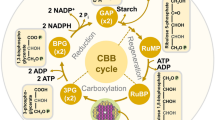Abstract
We discovered that some tree species have leaves whose adaxial sides show bright green–blue fluorescence upon exposure to ultraviolet irradiation. In total, 141 native Japanese species belonging to 47 families were analyzed, and the brightness of the leaf fluorescence, represented by the L* values (Lab color space) of the pictures, was evaluated. The species possessing the brightest fluorescent leaves, with L* > 50, were Camellia japonica, Camellia sasanqua, and Cleyera japonica of Theaceae, Osmanthus heterophyllus and Ligustrum japonicum of Oleaceae, Aucuba japonica of Garryaceae, and Trochodendron aralioides of Trochodendraceae. These species are propagated by pollination or seed dispersion by birds, except T. aralioides. The fluorescence was specifically observed in the cuticle tissues of the epidermal cells, indicating that the fluorescence is a signal to other organisms that can perceive the fluorescence under natural light. Species possessing the bright leaves represented 5% of the total species tested, while species possessing dark leaves, with L* ≤ 40, represented 88.6%. We deduce that the fluorescence enables the organisms to easily distinguish the minority species possessing bright leaves from the surrounding plants, which were mostly trees species with dark leaves. The structure of A. japonica var. borealis, in which dark leaves only surround its fruits while the rest of the tree is covered by bright leaves, may be useful to signal the presence of fruits to the organisms. We hypothesize that the fluorescence contributes to the propagation of the tree species by helping birds to distinguish these particular trees and/or locate the fruits.








Similar content being viewed by others
References
Arnold KE, Owens IPF, Marshall NJ (2002) Fluorescent signaling in parrots. Science 295:92–92
Curcio CA, Allen KA (1990) Topography of ganglion cells in human retina. J Comp Neurol 300:5–25
Fukui A (2003) Relationship between seed retention time in bird’s gut and fruit characteristics. Ornithol Sci 2:41–48
Fukuta N, Miyasaka M, Saito R, Kuchitsu K, Nakayama M (2005) The relationship between characteristics of optical image under UV light and flavonoid content in acyanic petals of Eustoma grandiflorum. Hort Res (Japan) 4:147–151
Goulas Y, Moya I, Schmuck G (1990) Time-resolved spectroscopy of the blue fluorescence of spinach leaves. Photosynth Res 25:299–307
Kominami Y, Sato T, Takeshita K, Manabe T, Endo A, Noma N (2003) Classification of bird-dispersed plants by fruiting phenology, fruit size, and growth form in a primary lucidophyllous forest: an analysis, with implications for the conservation of fruit bird interactions. Ornithol Sci 2:3–23
Lang M, Stober F, Lichtenthaler HK (1991) Fluorescence emission spectra of plant leaves and plant constituents. Radiat Environ Biophys 30:333–347
Nakayama M, Tanikawa N, Morita Y, Ban Y (2013) Comprehensive analyses of anthocyanin and related compounds to understand flower color change in ion-beam mutants of cyclamen (Cyclamen spp.) and carnation (Dianthus caryophyllus). Plant Biotechnol 29:215–221
Rahman ML, Sugita S, Aoyama M, Sugita S (2006) Number, distribution and size of retinal ganglion cells in the jungle crow (Corvus macrorhynchos). Anat Sci Int 81:253–259
Sasaki M (2006) E to data de yomu taiyoukou shigaisen—Taiyou to kashikoku tsukiau houhou. Center for Global Environmental Research in National Institute for Environmental Studies, Japan Publishing in Website (in Japanese). http://www.cger.nies.go.jp/publications/report/m018/all_M018.pdf. Accessed May 2006
Stober F, Lichtenthaler HK (1993) Studies on the constancy of the blue and green fluorescence yield during the chlorophyll fluorescence induction kinetics (Kautsky effect). Radiat Environ Biophys 32:357–365
Sugita S (2007) Chorui no Sikakuzyuyoukikou (in Japanese). Soc Biomech Jpn 31:143–149
Tanikawa N, Kashiwabara T, Hokura A, Abe T, Shibata M, Nakayama M (2008) A peculiar yellow flower coloration of camellia using aluminum flavonoid interaction. J Jpn Soc Hort Sci 77:402–407
Tanikawa N, Onozaki T, Nakayama M, Shibata M (2010) Maternal origin of ‘Tarokaja’ and other Wabisuke camellia cultivars indicated by chloroplast DNA variation. J Jpn Soc Hort Sci 79:77–83
Tanikawa N, Yoshida K, Kondo T, Mizuno T, Iwashina T, Nakayama M (2011) Urakunoside, a new tetraglycosyl kaempferol from petals of the Wabisuke camellia cv. Tarokaja. Biosci Biotechnol Biochem 75:2046–2048
Yumoto T (1987) Pollination systems in a warm temperature evergreen broad-leaved forest on Yaku island. Biol Res 2:133–145
Acknowledgements
We thank Dr. Yoshinori Murai for assistance of sample collection, Dr. Michio Shibata for donation of a flower picture and Dr. Kyutaro Kishimoto for valuable discussion.
Author information
Authors and Affiliations
Corresponding author
Electronic supplementary material
Below is the link to the electronic supplementary material.
Rights and permissions
About this article
Cite this article
Nakayama, M., Iwashina, T. Characteristics of green–blue fluorescence generated from the adaxial sides of leaves of tree species. J Plant Res 130, 301–310 (2017). https://doi.org/10.1007/s10265-016-0903-3
Received:
Accepted:
Published:
Issue Date:
DOI: https://doi.org/10.1007/s10265-016-0903-3




